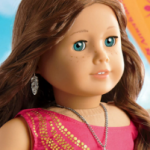It’s beginning to look a lot like Christmas, and we’ve still got a month to go. An e-mail from my bank reminds me they’ll have a drop-off box for Toys for Tots.
Definitely not on my list: an American Girl doll.
These dolls are pricey ($110 and up), but that’s not why I won’t buy them. American Girl used to be an amazing brand. Now it’s just an industry—and a pretty unsettling one.
Once upon a time
In 1986, Pleasant Rowland started a mail order firm, Pleasant Company, selling dolls from different periods of American history. A former elementary school teacher, Rowland sought “to give girls an understanding of America’s past and a sense of pride in the traditions they share with girls of yesterday.”
Each American Girl doll had a series of six books. And, of course, clothes. Bonnets, pinafores, pantaloons and other merchandise were key to major girl appeal. Amid the craft kits and accessories, though, were some interesting stories in which the girls dealt with real issues of the times: poverty, war, slavery, and prejudice, among others.
In A Lesson for Samantha, for example, wealthy Victorian-era Samantha Parkington learns about the harsh realities of sweatshops from Nellie, a poor servant girl she’s befriended, whose younger siblings work in a factory. At an award ceremony at her elite school, Samantha speaks out against child labor before an audience of society ladies whose wealth may come from those factories.
It was a remarkable brand. High quality, high priced, high margin items were marketed well (smartly targeting grandparents, for example). But it also offered engagement on deeper levels, connecting with themes of social and political history, and with values of empathy, courage, tolerance, resourcefulness and more. It was a brand you could root for.
40 Shades of bland
In 1998 Mattel bought the brand, netting Pleasant Rowland a cool $700 million. Since then, the company has taken all the edges off. The original dolls have been sidelined as “Historical Characters.” Outspoken Samantha and her peers Kirsten, the hard-working Scandinavian homesteader, and headstrong Colonial-era Felicity have been “archived.” World War II patriot Molly disappears Dec. 31st.
Center stage is reserved for the customizable “My American Girl” line with 40 configurations, offered Starbucks-style. Skin: Light, medium or dark? Eyes? Hair? Would you like layers or waves with that?
Another highlight is Girl of the Year. This year’s model, Saige, hosts a bake sale for an arts program (and rides her pony in the arts parade, pony sold separately). Next year we’ll have Isabelle, a blonde ballerina. Prior Girls of the Year are also mostly white, upper-middle class, with very local concerns. One is literally a backyard issue, when nature-loving Lanie frets about her neighbor using pesticides.
Accessorizing for Aspen
The current 100+ page holiday catalogue offers accoutrements of a life most children can only dream of: music lessons, gymnastics, a spa chair—complete with footbath for a relaxing pedi. What to wear to the Winter Chalet with flickering fireplace and fake hot cocoa ($110)? The Pretty Pink Coat Set with faux fur ($34) and Snowy Earmuffs ($10)? Or the Snowboard Outfit ($34) with Snowboard and Gear ($34)?
American Girl today is an unqualified business success. Sales are second only to Barbie. But something has been lost. The brand used to be more than an ordinary toy to those who bought the dolls and those who played with them. Today it’s a stylish accessory, an upscale Barbie.
New girl in town
Last week a viral video hit my inbox. (The two-minute introductory video for GoldieBlox based on the Beastie Boys song “Princess Machine” is now in copyright dispute, so I can no longer link to it, alas.) Founded by Debbie Sterling, a Stanford engineering grad, and funded through a Kickstarter campaign, the startup aims to “get girls building.” Noting that 89% of engineers worldwide are men, the website states the company’s mission explicitly:
In a world where men largely outnumber women in science, technology, engineering and math…and girls lose interest in these subjects as early as age 8, GoldieBlox is determined to change the equation…By designing a construction toy from the female perspective, we aim to disrupt the pink aisle and inspire the future generation of female engineers.
According to GoldieBlox, the construction set + story format is designed to tap girls’ strong verbal skills and bolster confidence in spatial skills. The kits sell for around $30. Also available: t-shirts, hoodies, and even onesies emblazoned with “More than just a princess.” Clearly, GoldieBlox would like to make money—ideally, a lot of it.
Building Brand America
Countless stories weave together across many levels to create the America we experience here and the America others perceive abroad.
On a business level, Pleasant Rowland offers an archetypal American success story. Mattel’s evolution of the American Girl brand is another classic business tale we recognize instantly. GoldieBlox’s story is just unfolding: it’s a strong idea that looks well executed, but will kids like the toys? Does the brand have legs? It’s too early to tell.
On a mission level, American Girl’s aim is bland and vague: “celebrating girls and all they can be.” As a division of Mattel, though, it has a classic objective: maximizing shareholder value. Larger, specific visions characterize both Pleasant Company and GoldieBlox. GoldieBlox also hopes to affect society as a whole.
On a cultural level, there is a huge difference between the stories offered by the original American Girl dolls and today’s dolls, quite literally. Their paraphernalia, settings and concerns teach children different things—and help create a different America. As does GoldieBlox.
When we buy gifts for children, we want to delight them. But we also want them to lead delightful lives. As entrepreneurs, employees, and consumers, our choices have an impact on both our immediate worlds and on the larger story of America. At every turn we have the opportunity to answer the question: Who do we want to be?




